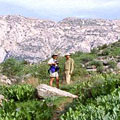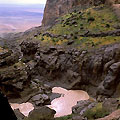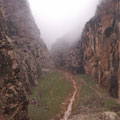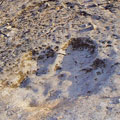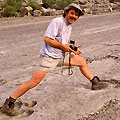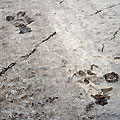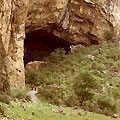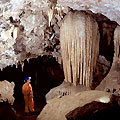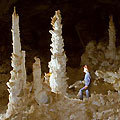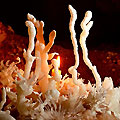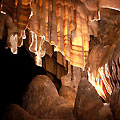Koyten Dag Nature Reserve
Nature Reserves of Turkmenistan
Koyten Dag Nature Reserve was created to protect the largest remaining Ibex populations in Central Asia. These long-horned mountains goats, as well as a significant number of Urials (Ovis ammon vignei), an endangered mountain sheep species, inhabit the steep canyons and flower covered valleys of the low ridges of the Koyten Dag Mountains, leading to Turkmenistan's tallest peak, Ayrybaba (3,137m).
Koyten Dag is also well-known for its "dinosaur plateau" with 438 well preserved fossilized dinosaur footprints, as well as for its caves, considered the most beautiful and interesting caves in the former Soviet Union. The mountain can be discovered via numerous climbing and trekking routes located along the entire ridge.
The Koytendag State Nature Reserve was founded in November, 1986, and is situated on the western slopes of the Koytendag Mountains, a spur of the Gissar range of the great Pamir-Alay mountain system. The territory of the Reserve is 27,139ha. The main aim of the Reserve's creation is the protection of the unique nature of the Kugitang mountain range and its bordering territories, and the development of sustainable ecosystems, in particular the protection of Capra falconeri (a very rare species of wild goat included in the Red Book of CITES).
The Koytendag region is located close to the border with Uzbekistan in the east of Turkmenistan. In this area one can see the Koytendag mountains, and peak Ayry Baba, the highest point in Turkmenistan at 3,137 m above sea level; the grandiose "Umbar Dere" canyon, with 28 m waterfalls; the plateau of Dinosaurs, with 438 fossilized Dinosaur footprints; the unique, hydrogen sulphate hot spring, "Gainar Baba"; "Kyrk gyz" canyon; and karst caves. The for a and fauna of Koytendag, are both unique: on the foothills of the Kopetdag mountains one can spot the spiral horned goat, a rare Buldiara species of mountainous ram.
It should be noted that Koytendag is a unique natural region. There are many sights: from those widely known inside the country and abroad to several that will be opened for the first time ever to the public. For example, the prospect of organizing climbs to the highest mountain in Turkmenistan, Ayribaba (3,139m), situated near the preserve is quite exciting. Or trips and hikes to the small plateau near the village of Khojapil Ata, where remains of dinosaurs from 150 million years ago have been found. Over 500 giant petrified footprints of these animals were found in 1980's.
A point of specific interest for specialists and amateurs are the numerous caves and other underground complexes. The mysteries of the Karluk caves in the south of Koytendag have been narrated in many folk legends and stories. The inside of such underground "structures" as Khashymyuk and Gapgotan are striking with their unique beauty. However, there are still many caves which have kept their secrets to the present. One of them was named after the national hero of the Turkmen, Georogly-Beg. Legend says that this worrier and poet lived there during his last years.
The National natural park includes healing sulphur springs near the foothills of Gaynarbaba, and thickets of trees called Unabi with a disinfectant air cleaning capability. The fruit of these unique trees is famous for being used by the local population as a medicine for heart, kidney, liver and stomach diseases since ancient times. Scientists call the biggest grove of Unabi in Central Asia, near the village of Koyten, an "open air drugstore". There are also cypress, archa, almond and pistachio trees on the upper levels of the mountains.
Specialists have no doubt that if taken care of correctly, the future park may become a real place of pilgrimage for true lovers of exotic nature from all over the world.
The Caves
Ninety million years ago, when the modern desert territory of Central Asia was soaked by plentiful rains and a large ocean washed the foothills of the young mountains, the water began to dissolve the rock and to seek shelter in new caves. Afterwards, the caves filled with clay and stayed that way for a long period of time, from the Neogenic to the Middle Quaternary. The mountains rose, together with the caves full of clay, whereupon the clay was washed away and the karst cave system was born.
The first historical mention of the caves we find in the "Diodorus Siculus Library" from about 2,000 years ago. The discovery of a smuggler's mummy, along with goods in cave, proves that caves had been used by smugglers for shelter nearly 20 centuries ago. The name of the main caves of the Cupp-Coutan ridge can be translated from Turkmen as "sheep-fold"; these have witnessed the caves' utilization throughout human history. New exploration of caves was completed by Ashkhabad geologist Yalkapov in 1956. Yalkapov found several of caves and made the first maps of the cave system. However, the fame of the caves was connected with the beginning of industrial extraction of marble onyx and the following public outcry for the caves' protection. The fame of the caves in scientific circles was due to the works of Maltsev, who periodically published scientific and popular articles about his research and protection of caves. The best maps of the caves and a list of their minerals were also made by Maltsev. During the last few years there was a hope of organizing tours through the caves. Unfortunately, this is not very practical because this area is rarely visited by travelers. Currently, most Russian cavers consider the Koytendag Caves to be the most beautiful and interesting. There are many different legends about the Koytendag caves.
An absolute wonder of these beautiful sports is the so-called Garlyk caves. The Cafe - a hall of small and low grottos with stalactites and stalagmites, columns in the shape of big candles, minarets, webs and needles is a really fantastic sight. Another attraction is the Gulshirin cave. The cave entrance is very narrow, only 0.5m high. An amazing hall called "Fairy Tale", with its gypsum curtain and stucco molding of ceiling, decorated with aragonite "roses" and other "flowers" of unbelievable beauty create a science fiction type atmosphere. Every cave has its own collection of minerals in unusual forms, which are impossible to describe. It is worth a visit to see them. In the region, cave exploration processes are developing, and as a result there are many various caves, mines, and paths. The first one is the Gap -Gutan cave. The amazing first two halls of the cave are known as Father Christmas and Snow Maiden. These two huge sized fairy figures are among the unusually shaped stalactites of calcite and gypsum. The cave entrance is very narrow, only 0.5 m high. In Koytendag every cave has a real variety of unusual mineral forms. It's difficult to express our impressions of such wonderful items of nature.
